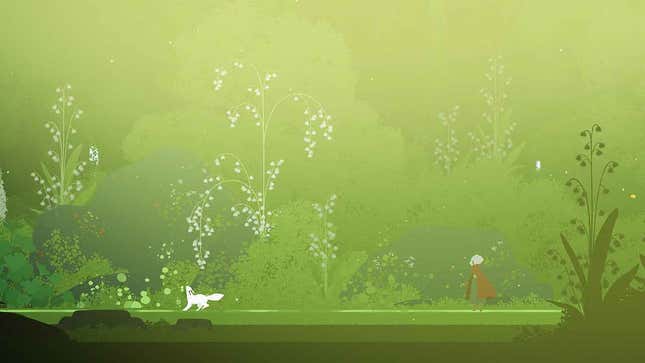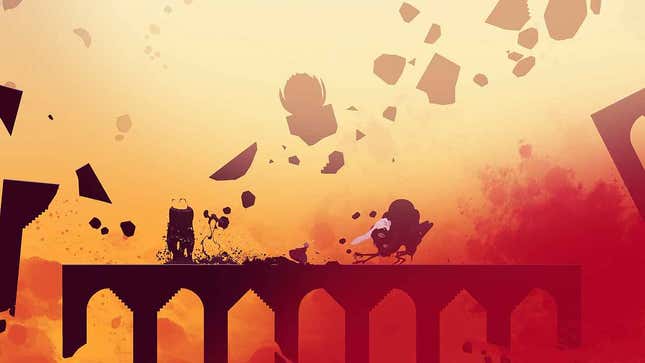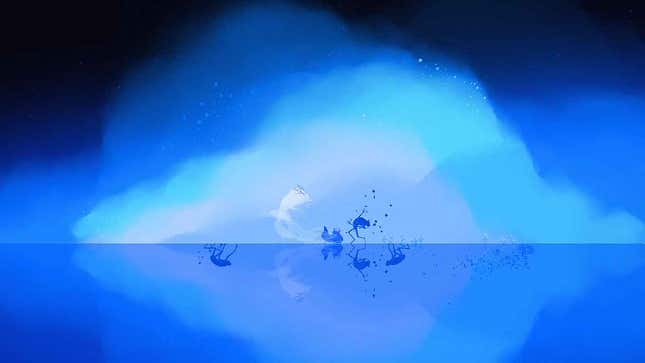The wolf does in fact die in Neva, the new platform-adventure game from Nomada Studio. That’s not really a spoiler, as the game’s reveal trailer showed this very moment off and it’s the very first thing you’ll experience when you start playing. What you’ll be wondering for the next five hours, however, is if the game’s titular wolf pup will suffer the same fate as their dearly departed parent.
As the second title from the developers of 2018’s Gris, a critically acclaimed puzzle-platformer about grief, Neva has a lot to live up to. Like its predecessor, Neva has gorgeous visuals and often-delicious platforming puzzles. The sophomore title falters, however, in how it executes on its often too-familiar themes. For those who have played Gris, this game’s distinctive art style and animation resembling that of a hand-drawn film make it abundantly clear the same team is behind it. That pedigree isn’t always a good thing, however, as the game fails to strike out on its own, instead falling back on creative choices we’ve seen before. Neva’s story about our relationship with nature and the cycle of life seems ripe with potential, but it never knows how to deliver on that promise.
A story of seasons

While the wolf pup gets top billing in Neva, that is not the part you play. Rather, you step into the shoes of Alba, a surrogate parent for the now orphaned Neva. A young woman living in a gorgeous forest inhabited by larger-than-life deer, boar, and wolves, Alba has known Neva seemingly since birth, as we see her fighting a wave of enemies made of some sort of nature-killing plague alongside the pup and their parent in the game’s opening cinematic. With the forest around them rapidly dying due to this new threat, the pair embark on a journey that’ll last a full cycle of the seasons (or roughly five hours of game time). Along the way, you’ll help guide Neva from a small, nervous pup into a colossal wolf as you fight off the now infected inhabitants of the world.
Before you even set out on your adventure, though, which has massive Princess Mononoke vibes throughout (if you couldn’t already tell from the giant wolf in the game’s opening and its female companion), you’ll likely be dazzled by Neva’s gorgeous visuals. Much like Gris before it, Neva takes a painterly approach to its presentation. An early shot of the game’s starring duo resting underneath a massive flowering tree is particularly stunning and sets the bar for every beautiful vista to come. The leaves of skyscraper-tall trees are composed of countless little colorful dots that smudge together in a way Georges Seurat would approve of. As the game begins in summer and progresses through the seasons, the color palette becomes more muted, with the growing infection killing nature also playing its part. Gris was a game that started in greyscale and had you bringing color into the world. Neva reverses that, and it’s a wonderful visual journey to go on.
Lone wolf and cub

You navigate Neva through 2D platforming, which sees you run, jump, double jump, and dash through its lush natural environments. There are plenty of platforming puzzles, but there’s also combat, a mechanic absent in Gris. While I was initially concerned about how combat would be integrated into this narrative-heavy platformer, after a full playthrough I can say it’s mostly okay. You’ll slash your way through a number of enemy varieties, some of which take a little more thought to defeat than others and be on your way. As Neva grows from season to season, you’ll also unlock new ways to incorporate them into battles. Combat isn’t particularly bad, but it also isn’t good enough to make it satisfying to engage with, which makes the game’s boss battles (which come near the end of every chapter) low points of your short adventure.
Platforming, on the other hand, feels delightful, which becomes especially true as Neva introduces new challenges. Yet, just as in Gris, these interesting variations on the game’s standard platforming often only get brief spotlights before being thrown away entirely. One area required me to navigate invisible platforms by looking at a reflection of the level, which made it so the controls felt backwards as I leapt through the air, hoping to not fall to my death. Subsequent rooms added more reflections and different perspectives, making them even more fun to navigate, but before long I was through this particular series of levels and would never face a similar challenge again. I can’t help but think it would have been better to have a smaller assortment of innovative wrinkles to the core gameplay that each got a bigger spotlight.
It’s the circle of life

When I previewed Neva this June, I came away excited for the potential of this story. But having completed it now, I find that it’s a game of potential that is never reached. In the game’s earliest chapter, Summer, Neva’s companionship feels meaningful, in part because you must constantly be aware of the young pup. If you aren’t paying attention, they’ll run off or fall off a ledge and struggle to follow you. Calling for Neva and petting them, which you can do at any time with the press of a button, promises that forging this bond between Alba and Neva will mean something.
Yet that never feels true in later chapters. Eventually Neva just becomes a tool for Alba (and you) to utilize during combat or platforming, but never a true partner. The focus on an NPC companion puts this game in conversation with the likes of Ico and The Last Guardian, but unlike those games, it fails to understand the importance of allowing such a companion some level of freedom that may sometimes grate against the player’s wishes but that ultimately leads to a wonderful symbiotic relationship forged through challenges.
In theory, the game’s combat serves a thematic purpose as well, in that it allows you to actively fight for a better world. As Alba and Neva make journey on, they’re constantly waylaid by the once-thriving fauna of the forest, now infested with the same corruption poisoning the land itself, and by engaging you directly in that struggle, the game seems to assert itself as an environmentalist call to arms. Unfortunately, however, these themes never go more than skin-deep. Beyond destroying the threat, Alba and Neva can’t work to meaningfully bring life back into the world. Neva is the only animal you as the player directly have responsibility over and interact with, and even they become nothing more than another tool to wield in the context of combat. There is a lot of set-up that left me waiting for the game to say something meaningful, but it never paid off. With the game’s narrative failing to commit to the environmentalist message, the inclusion of combat feels like an afterthought whose only real purpose is to give the player some busywork in the form of enemies to cut down.
Instead, Neva prioritizes a meditation on life and loss that too often feels half-baked and pales in comparison to Gris’ execution of the same themes. Much of Neva feels propped up by its predecessor to cover its weaknesses, with familiar themes and the same platforming (flaws and all) from Gris encouraging fans of that game to not look too closely at this game’s faults. Ultimately, when Neva attempts a final narrative twist that fully leans away from the initially compelling and original themes of its story, it’s too much of a shift too late in the game, and only serves to undermine the few unique choices this experience attempts. At least it’s short.
.




